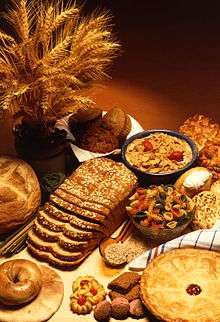Norin 10 wheat
Norin 10 wheat (小麦農林10号) is a semi-dwarf wheat cultivar with very large ears that was bred by Gonjiro Inazuka at an experimental station in Iwate Prefecture, Japan. In 1935, it was registered as a numbered cultivar by Ministry of Agriculture and Forestry Nōrinshō (農林省). Norin 10 grew to just two feet tall, instead of the usual four, which made it less prone to wind damage.
Norin 10 provided two very important genes, Rht1 and Rht2, that resulted in reduced-height wheats, thus allowing better nutrient uptake and tillage (when heavily fertilised with nitrogen, tall varieties grow too high, become top-heavy, and lodge).[1]
Cecil Salmon, a biologist and wheat expert on General Douglas MacArthur's team in Japan after 1945, collected 16 varieties of wheat including Norin 10, and sent these seeds to Orville Vogel.[2] These samples were used in 1952 by Norman Borlaug and collaborators and crossed with Mexican traditional varieties. They obtained the high-output varieties which were tested in India (Lerma Rojo 64 and Sonora 64) during the Green Revolution.
Norin 10 helped developing countries, such as India and Pakistan, to increase the productivity of their crops by approximately 60% during the Green Revolution.
See also
- Biodiversity
- Monkombu Sambasivan Swaminathan
References
- Reitz, L. P.; Salmon, S. C. (November 1968). "Origin, History, and Use of Norin 10 Wheat". Crop Science. 8 (6): 686–689. doi:10.2135/cropsci1968.0011183X000800060014x. Retrieved 30 April 2014.
- Borojevic, Katarina; Borojevic, Ksenija (July–August 2005). "The Transfer and History of "Reduced Height Genes" (Rht) in Wheat from Japan to Europe". Journal of Heredity. Oxford University Press. 96 (4): 455–459. doi:10.1093/jhered/esi060. Retrieved 30 April 2014.
External links
- Rht1 gene
- Ears of plenty: The story of wheat, The Economist, December 20, 2005
